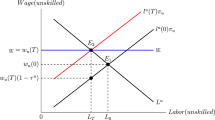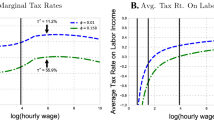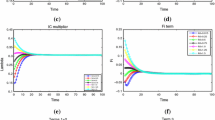Abstract
In this paper, we investigate the structure of the “Laffer curve” for taxes on labor and other factors of production, under different institutional frameworks of the labor market. Using a Cobb–Douglas production technology allows us to characterize important properties of the “Laffer curve” in terms of the wage share for a competitive labor market, the monopoly union model, the right-to-manage approach, the insider-dominated union, and efficient Nash bargains simultaneously. In this way, we are able to highlight the menu of factor tax systems, and thus of potential tax reforms available to a government, without perfect knowledge of the mechanism of the labor market. In particular, we show that the employment-maximizing tax system features a constant energy tax, while the energy mini-/maximizing tax system features a constant labor tax. We also illuminate to what extent these results must be modified if we either employ a CES production function, or if we allow for an endogenous reservation wage.
Similar content being viewed by others
References
Bayındır-Upmann, T., & Raith, M. G. (2003). Should high-tax countries pursue revenue-neutral ecological tax reforms? European Economic Review, 47, 41–60.
Bayındır-Upmann, T., & Raith, M. G. (2005). Unemployment and pollution—is one policy suited for two problems? The Economic Record, 81, 378–393.
Boeters, S. (2001). Green tax reform and employment: The interaction of profit and factor taxes (Discussion Paper No. 01-45). Center for European Economic Research
Bovenberg, A. L., & van der Ploeg, F. (1994). Environmental policy, public finance and the labor-market in a second-best world. Journal of Public Economics, 55, 349–390.
Bovenberg, A. L., & van der Ploeg, F. (1996). Optimal taxation, public goods and environmental policy with unvoluntary unemployment. Journal of Public Economics, 62, 59–83.
Bovenberg, A. L., & van der Ploeg, F. (1998). Consequences of environmental tax reform for unemployment and welfare. Environmental and Resource Economics, 12, 137–150.
Creedy, J., & McDonald, I. M. (1991). Models of trade union behaviour: A synthesis. Economic Record, 67, 346–359.
de Mooij, R. A., & Bovenberg, A. L. (1998). Environmental taxes, international capital mobility and inefficient tax systems: Tax burden vs. tax shifting. International Tax and Public Finance, 5, 7–39.
Gerber, A., & Upmann, T. (2006). Bargaining solutions at work: qualitative differences in policy implications. Mathematical Social Sciences, 52, 162–175.
Koskela, E., & Schöb, R. (1999). Alleviating unemployment: The case for Green tax reforms. European Economic Review, 43, 1723–1746.
Koskela, E., Schöb, R., & Sinn, H.-W. (1998). Pollution, factor taxation and unemployment. International Tax and Public Finance, 5, 379–396.
McDonald, I. M., & Solow, R. M. (1981). Wage bargaining and employment. American Economic Review, 71, 896–908.
Author information
Authors and Affiliations
Corresponding author
Rights and permissions
About this article
Cite this article
Upmann, T. A positive analysis of labor-market institutions and tax reforms. Int Tax Public Finance 16, 621–646 (2009). https://doi.org/10.1007/s10797-008-9079-7
Published:
Issue Date:
DOI: https://doi.org/10.1007/s10797-008-9079-7




